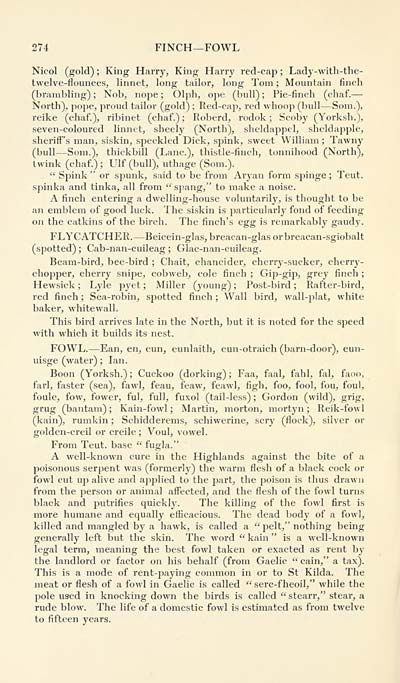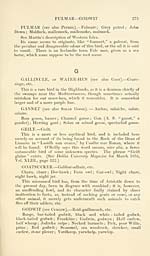Download files
Complete book:
Individual page:
Thumbnail gallery: Grid view | List view

274 FINCH— FOWL
Nicol (gold) ; King Harry, King Harry red-cap ; Lady-with-the-
twelve-flounces, linnet, long tailor, long Tom ; Mountain finch
(brambling) ; Nob, nope ; Olpli, ope (bull) ; Pie-finch (chaf. —
North), pope, proud tailor (gold) ; Red-ca}!, red whoop (bull — Som.),
reike (chaf.), ribinet (chaf.) ; Roberd, rodok ; Scoby (Yorksh.),
seven-coloured linnet, sheely (North), sheldappel, sheldapple,
sheriff's man, siskin, speckled Dick, spink, sweet William ; Tawny
(bull — Som.), thickbill (Lane), thistle-finch, tonnihood (North),
Iwink (chaf.) ; Ulf (bull), uthage (Som.).
" Spink " or spunk, said to be from Aryan form s^iinge ; Teut.
spinka and tinka, all from " sjiang," to make a noise.
A finch entering a dwelling-house voluntarily, is thought to be
an emblem of good luck. The siskin is particularly fond of feeding
on the catkins of the birch. The finch's egg is remarkably gaudy.
FLYCATCHER. — Beicein-glas, breacan-glasorbreacan-sgiobalt
(spotted) ; Cab-nan-cuileag ; Glac-nan-cuileag.
Beam-bird, bee-bird ; Chait, chancider, cherry-sucker, cherry-
chopper, cherry snipe, cobweb, cole finch ; Gip-gip, grey finch ;
Hewsick ; Lyle pyet ; Miller (young) ; Post-bird ; Rafter-bird,
red finch ; Sea-robin, spotted finch ; Wall bird, wall-plat, white
baker, whitewall.
This bii'd arrives late in the North, but it is noted for the speed
with which it builds its nest.
FOWL. — Ean, en, eun, eunlaith, eun-otraich (barn-door), eun-
uisge (water) ; Ian.
Boon (Yorksh.) ; Cuckoo (dorking) ; Faa, faal, fahl, fal, faoo,
farl, faster (sea), fawl, feau, feaw, feawl, figh, foo, fool, fou, foul,
foule, fow, fower, ful, full, fuxol (tail-less) ; Gordon (wild), grig,
grug (bantam) ; Kain-fowl ; Martin, morton, mortyn ; Reik-fowl
(kain), rumkin ; Schidderems, schiwerine, scry (flock), silver or
golden-creil or creile ; Voul, vowel.
From Teut. base " fugla."
A well-known cure in the Highlands against the bite of a
poisonous serpent was (formerly) the warm flesh of a black cock or
fowl cut up alive and applied to the part, the poison is thus drawn
from the person or animal affected, and the flesh of the fowl turns
black and putrifies quickly. The killing of the fowl first is
more humane and equally efficacious. The dead body of a fowl,
killed and mangled by a hawk, is called a " pelt," nothing being
generally left but the skin. The word " kain " is a well-known
legal term, meaning the best fowl taken or exacted as rent by
the landlord or factor on his behalf (from Gaelic " cain," a tax).
This is a mode of rent-paying common in or to St Kilda. The
meat or flesh of a fowl in Gaelic is called "serc-fheoil," while the
pole used in knocking down the birds is called "stearr," stear, a
rude blow. The life of a domestic fowl is estimated as from twelve
to fifteen years.
Nicol (gold) ; King Harry, King Harry red-cap ; Lady-with-the-
twelve-flounces, linnet, long tailor, long Tom ; Mountain finch
(brambling) ; Nob, nope ; Olpli, ope (bull) ; Pie-finch (chaf. —
North), pope, proud tailor (gold) ; Red-ca}!, red whoop (bull — Som.),
reike (chaf.), ribinet (chaf.) ; Roberd, rodok ; Scoby (Yorksh.),
seven-coloured linnet, sheely (North), sheldappel, sheldapple,
sheriff's man, siskin, speckled Dick, spink, sweet William ; Tawny
(bull — Som.), thickbill (Lane), thistle-finch, tonnihood (North),
Iwink (chaf.) ; Ulf (bull), uthage (Som.).
" Spink " or spunk, said to be from Aryan form s^iinge ; Teut.
spinka and tinka, all from " sjiang," to make a noise.
A finch entering a dwelling-house voluntarily, is thought to be
an emblem of good luck. The siskin is particularly fond of feeding
on the catkins of the birch. The finch's egg is remarkably gaudy.
FLYCATCHER. — Beicein-glas, breacan-glasorbreacan-sgiobalt
(spotted) ; Cab-nan-cuileag ; Glac-nan-cuileag.
Beam-bird, bee-bird ; Chait, chancider, cherry-sucker, cherry-
chopper, cherry snipe, cobweb, cole finch ; Gip-gip, grey finch ;
Hewsick ; Lyle pyet ; Miller (young) ; Post-bird ; Rafter-bird,
red finch ; Sea-robin, spotted finch ; Wall bird, wall-plat, white
baker, whitewall.
This bii'd arrives late in the North, but it is noted for the speed
with which it builds its nest.
FOWL. — Ean, en, eun, eunlaith, eun-otraich (barn-door), eun-
uisge (water) ; Ian.
Boon (Yorksh.) ; Cuckoo (dorking) ; Faa, faal, fahl, fal, faoo,
farl, faster (sea), fawl, feau, feaw, feawl, figh, foo, fool, fou, foul,
foule, fow, fower, ful, full, fuxol (tail-less) ; Gordon (wild), grig,
grug (bantam) ; Kain-fowl ; Martin, morton, mortyn ; Reik-fowl
(kain), rumkin ; Schidderems, schiwerine, scry (flock), silver or
golden-creil or creile ; Voul, vowel.
From Teut. base " fugla."
A well-known cure in the Highlands against the bite of a
poisonous serpent was (formerly) the warm flesh of a black cock or
fowl cut up alive and applied to the part, the poison is thus drawn
from the person or animal affected, and the flesh of the fowl turns
black and putrifies quickly. The killing of the fowl first is
more humane and equally efficacious. The dead body of a fowl,
killed and mangled by a hawk, is called a " pelt," nothing being
generally left but the skin. The word " kain " is a well-known
legal term, meaning the best fowl taken or exacted as rent by
the landlord or factor on his behalf (from Gaelic " cain," a tax).
This is a mode of rent-paying common in or to St Kilda. The
meat or flesh of a fowl in Gaelic is called "serc-fheoil," while the
pole used in knocking down the birds is called "stearr," stear, a
rude blow. The life of a domestic fowl is estimated as from twelve
to fifteen years.
Set display mode to: Large image | Transcription
Images and transcriptions on this page, including medium image downloads, may be used under the Creative Commons Attribution 4.0 International Licence unless otherwise stated. ![]()
| Early Gaelic Book Collections > Blair Collection > Gaelic names of beasts (mammalia), birds, fishes, insects, reptiles, etc > (300) |
|---|
| Permanent URL | https://digital.nls.uk/79332847 |
|---|
| Description | A selection of books from a collection of more than 500 titles, mostly on religious and literary topics. Also includes some material dealing with other Celtic languages and societies. Collection created towards the end of the 19th century by Lady Evelyn Stewart Murray. |
|---|
| Description | Selected items from five 'Special and Named Printed Collections'. Includes books in Gaelic and other Celtic languages, works about the Gaels, their languages, literature, culture and history. |
|---|

